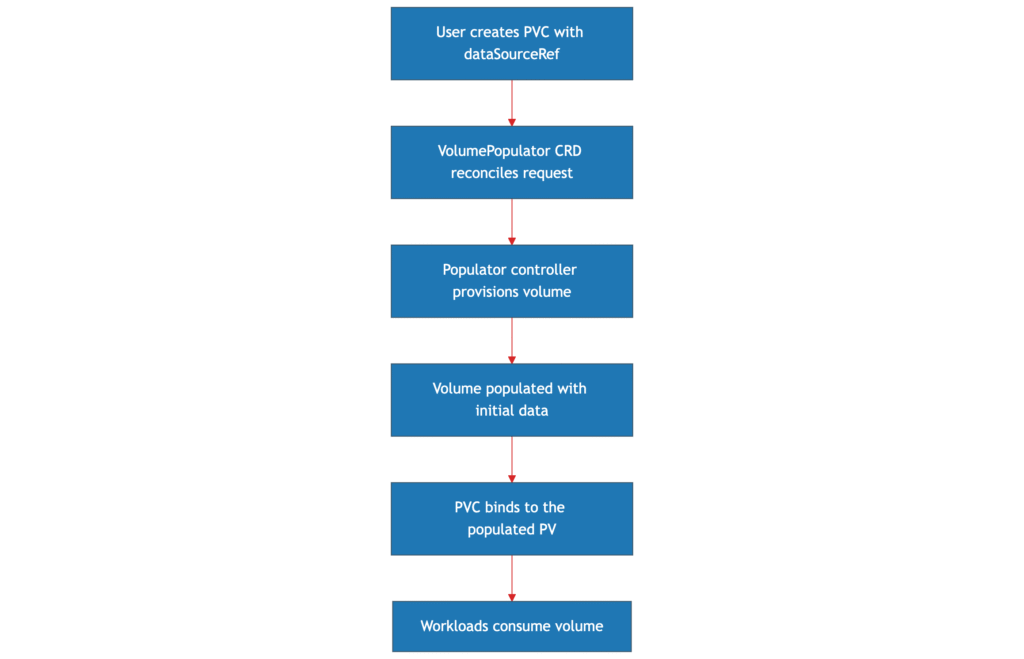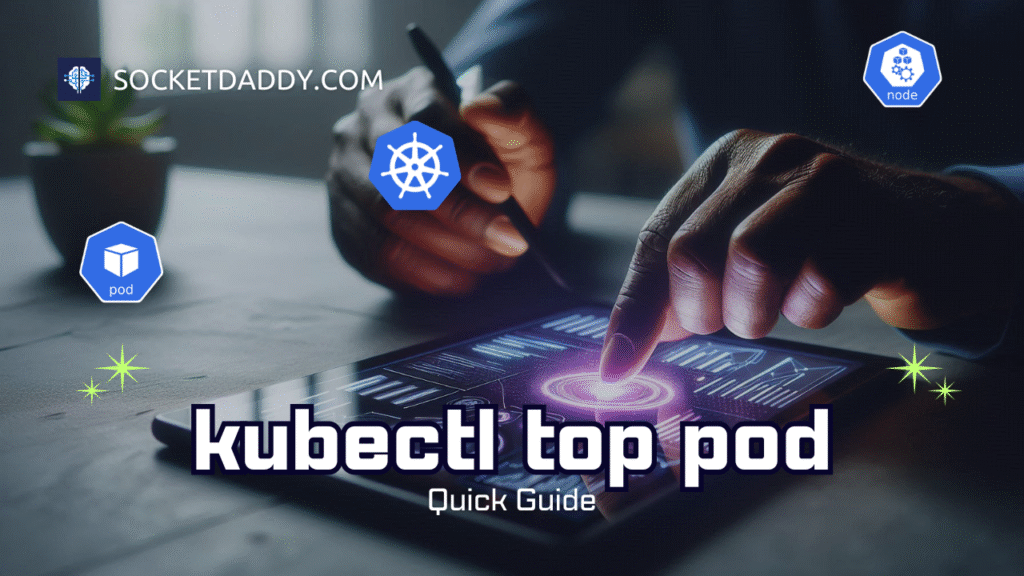Kubernetes 1.33 introduces volume populators as a generally available (GA) feature, revolutionising how PersistentVolumeClaims (PVCs) consume data sources. This unlocks custom resource-backed volumes beyond built-in sources, enabling advanced provisioning strategies and enhanced flexibility in storage workflows.
The new AnyVolumeDataSource feature gate is always enabled in v1.33, allowing users to specify any custom resource as the data source of a PVC using dataSourceRef. This extends Kubernetes persistent storage capabilities for complex, dynamic storage ecosystems.
TL;DR: Key Takeaways on Kubernetes Volume Populators
- Volume populators have reached GA in Kubernetes 1.33, supported via
AnyVolumeDataSourcefeature gate always enabled. dataSourceRefin PVC spec now supports referencing any appropriate custom resource or API group.- Four major enhancements include general availability, improved API contract stability, refined snapshot handling, and broader CSI driver integrations.
- VolumePopulator custom resources define volume data creation/pre-population logic for specific storage providers.
- Supports new use-cases in event-driven architectures and cloud-native storage workflows requiring richer volume provisioning semantics.
- Improves lifecycle management of PVCs with dynamic data sourcing and advanced capacity provisioning.
Table of contents
- TL;DR: Key Takeaways on Kubernetes Volume Populators
- Kubernetes Volume Populators: Feature Overview
- Volume Populators API Specification and Usage
- Key Enhancements in Kubernetes 1.33 Volume Populators
- VolumePopulator Custom Resource Lifecycle and Concepts
- Storage Class and Capacity Considerations with Volume Populators
- Security and Access Controls in Volume Populator Usage
- Use-Cases Including Event-Driven Architectures
- Example Workflow Diagram
- Summary
- References
- Read more
Kubernetes Volume Populators: Feature Overview
Kubernetes PersistentVolumeClaims traditionally support limited data sources: volumes, snapshots, PVC templates. Volume populators widen this by enabling any custom resource that implements volume population logic to serve as a data source.
The AnyVolumeDataSource feature gate activates this capability. By v1.33, this gate is permanently enabled, marking the volume populators feature stable and production ready.
This transforms PVC requests, allowing them to specify a dataSourceRef pointing to a custom resource. The referenced resource must define how to provision or populate the volume’s initial content.
Volume Populators API Specification and Usage
Here is a simplified example of a PVC using a custom data source:
apiVersion: v1
kind: PersistentVolumeClaim
metadata:
name: pvc1
spec:
accessModes:
- ReadWriteOnce
resources:
requests:
storage: 10Gi
storageClassName: standard
dataSourceRef:
apiGroup: provider.example.com
kind: Provider
name: provider1
The dataSourceRef field replaces the older dataSource, offering more flexibility by allowing references to custom resource APIs instead of only built-in types.
Key Enhancements in Kubernetes 1.33 Volume Populators
Kubernetes v1.33 consolidates the volume populators status with four major improvements:
- General Availability: Feature moves from beta to stable, ensuring API contract consistency and backward compatibility for custom resource developers.
- API Stability: VolumePopulator CRD schema formalised. Controllers can rely on semantic versioning for future enhancements.
- Snapshot Handling Enhancements: Improved lifecycle for snapshots created as part of data population pipelines, with hooks for cleanup and incremental flows.
- Broader CSI Driver Support: Volume populators now better integrate with Container Storage Interface (CSI) drivers, enabling dynamic provisioning that leverages CSI’s advanced capabilities.
VolumePopulator Custom Resource Lifecycle and Concepts
The core concept is the VolumePopulator custom resource, which implements the logic to prepare volume data when a PVC is created.
Lifecycle overview:
- Creation: User creates a PVC with
dataSourceRefpointing to a VolumePopulator resource. - Population: The VolumePopulator controller fetches required source data and populates a PersistentVolume with initial content.
- Binding: The PVC binds to the populated PersistentVolume for use by workloads.
- Deletion: On PVC deletion, volume and data cleanup policies defined in VolumePopulator govern retention or snapshots.
This approach separates storage provisioning and data population concerns, making the flow declarative and extensible.
Storage Class and Capacity Considerations with Volume Populators
Volume populators work in tandem with storage classes and dynamic provisioning. Key points include:
- StorageClass Parameters: Must specify the VolumePopulator CRD kind and controller endpoint to handle requested data population.
- Provisioning Modes: Supports immediate population during PVC binding or delayed population as asynchronous jobs.
- Capacity Accounting: PVC requests storage size as usual;VolumePopulator controllers ensure volume volume content fits declared capacity.
- Snapshots and Clones: Can integrate with snapshot controllers to create initial volume states from snapshots.
Security and Access Controls in Volume Populator Usage
Security is critical when using custom data sources. VolumePopulators adopt Kubernetes RBAC concepts:
- Access to the VolumePopulator custom resource APIs requires explicit RBAC permissions.
- Data source references only accepted from authorised namespaces or cluster scopes.
- Controllers run with least-privilege principles, leveraging Pod Security and
SecurityContextconstraints. - Space quotas on PVCs and VolumePopulator resources manage resource consumption and prevent abuse.
Use-Cases Including Event-Driven Architectures
Volume populators enable complex workflows in event-driven and cloud native environments. Examples:
- Pre-populated Volumes: Automatically populate a PVC with data fetched from remote databases or object stores at provisioning time.
- Snapshot-based Workflows: Create volumes that restore from snapshots triggered by events or policies.
- Custom CSI Integrations: Dynamic volume provisioning that reacts to application lifecycle events via CRDs.
- Data Pipelines: Event-driven data ingestion with volumes pretuned for batch processing or ML jobs.
Example Workflow Diagram

Summary
Kubernetes 1.33’s volume populators GA release marks a crucial step forward for persistent storage flexibility. By enabling PVCs to reference arbitrary custom resource data sources, Kubernetes unlocks sophisticated volume provisioning patterns vital for cloud native and event-driven applications.
The adoption of VolumePopulator CRDs with stable APIs and improved CSI support addresses many previous limitations. Organisations can now implement complex pre-population, snapshot restoration, and data-driven volume workflows with Kubernetes-native constructs.
This feature demands careful RBAC configuration and storage class design but offers strong benefits in automation and integration. Kubernetes practitioners working with persistent storage should explore volume populators in v1.33 to advance their storage architectures.
References
Read more
PostHashID: 92ef7de00e7e79dd86605b97d6eac4ca2537481c7362dc48988753e7b3fe8a26




